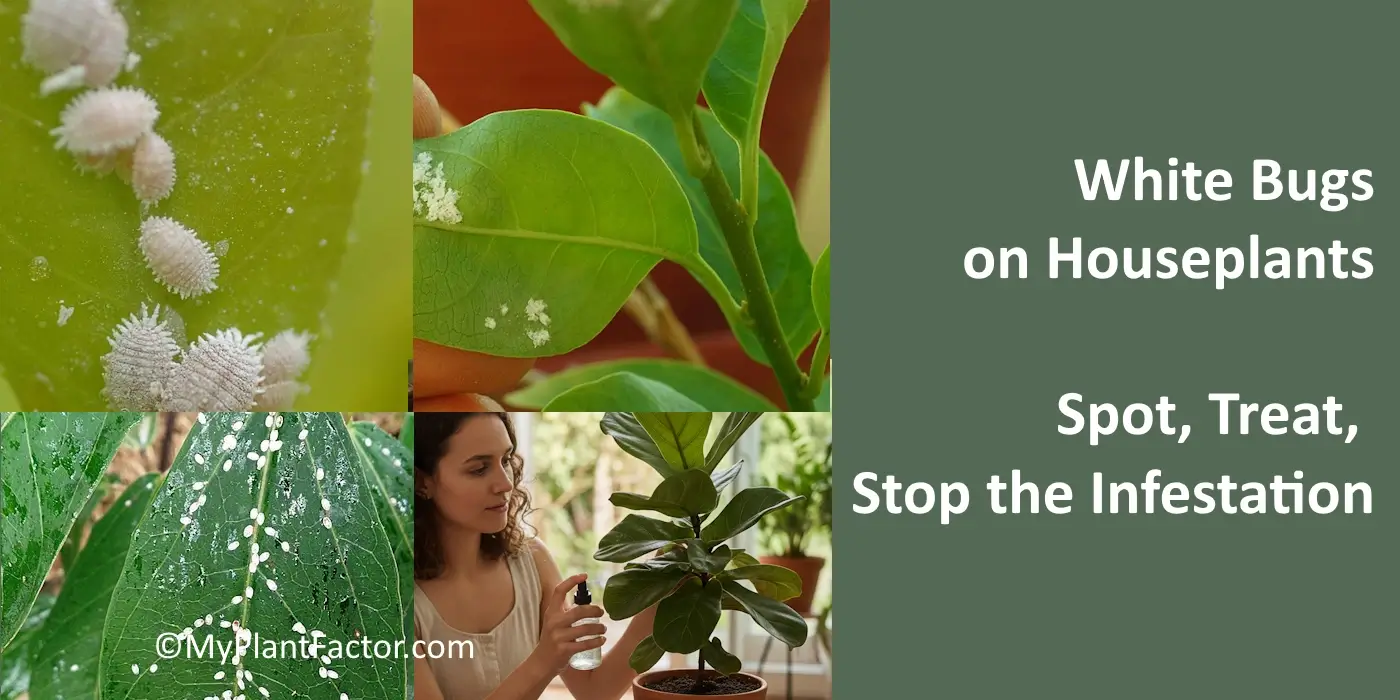
White Bugs on Houseplants: Spot, Treat, and Stop the Infestation

Any plant parent knows that spotting white bugs on houseplants feels like a kick in the gut. You might notice tiny white flecks crawling on plant soil, or you may see white flying bugs hovering over your hoyas, monsteras, fiddle-leaf figs, or philodendrons. But the worst, and most common type of white bugs on indoor plants are fuzzy mealybugs.
Table of Contents
- What Are the Tiny White Bugs on My Plants?
- How Do White Bugs Get Into Your Houseplants?
- Early Signs of White Bugs on Houseplants
- Common Types of White Bugs on Houseplants
- Are White Bugs Harmful to Houseplants?
- How to Get Rid of White Bugs Naturally: Step-by-Step Guide
- Preventing White Bugs from Coming Back
- Are Natural White Bug Treatments Safe for Pets and Kids?
- Plant Recovery Timeline After White Bug Treatment
- White Bugs on Houseplants — FAQs
The pesky white pests seem to show up overnight. They turn glossy leaves dull and sticky, like your houseplants just lost a fight. Before panic turns to despair, you’ll try wiping, shaking, or even whispering threats. But the tiny white bugs keep coming back.
The good news is that you can eradicate white bugs on houseplants with natural solutions. Depending on the insect, rubbing alcohol, neem oil, and a hydrogen peroxide soil flush, coupled with some persistence, can turn things around faster than you think.
Read on to discover what’s really living on your plants and how to make sure the white bugs never return.
What Are the Tiny White Bugs on My Plants?
Most types of white bugs on houseplants are soft-bodied sap-sucking insects. Depending on where you find them, they’re most likely mealybugs, whiteflies, root aphids, or even soil mites. Some perch like dust on stems; others burrow deep in potting mix, clinging to plant roots like squatters.
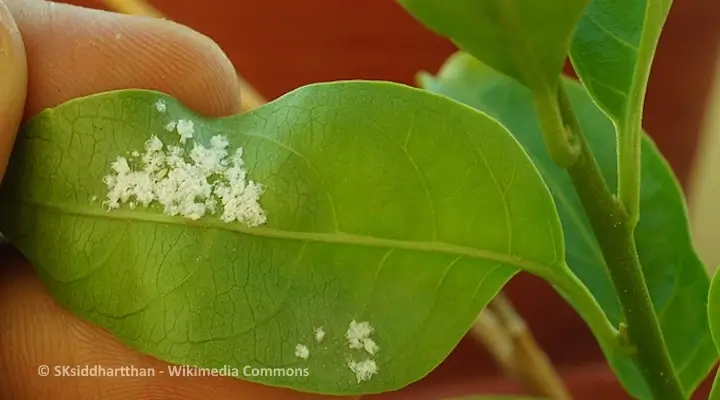
Sometimes you realize you’ve got a problem with white bugs before you see the pesky insects. Noticed the following?
- Leaves are curling or turning yellow
- Sticky honeydew on stems
- Black sooty mold on foliage?
White bug problem.
And here’s the kicker—they spread fast. One leaf to the next, one plant to another. Blink, and your living room’s a bug buffet.
So before you panic-buy every spray on the shelf, let’s figure out exactly which kind of white pest you’re facing—and why they picked your plants in the first place.
How Do Tiny White Bugs Get Into Your Houseplants?
Mealybugs and wooly aphids hitch rides on new plants, thrifted pots, or even cling to your hands after pruning outdoor plants. Some come buried in bagged potting mix, others drift in through an open window, chasing humidity like it’s a summer party.
Once they land, your cozy indoor setup becomes their Airbnb—warm air, soft leaves, zero predators. That’s all they need to settle in, multiply, and turn your peace lily into a buffet.
It’s not a sign of neglect; it’s just nature taking advantage of comfort. The key is spotting the invasion early—before those invisible guests start unpacking.
Think you’re seeing webbing instead of white fluff? That’s another problem entirely—meet the true leaf-wreckers in Spider Mites on Indoor Plants: Signs and Solutions.
Early Signs of White Bugs on Houseplants
You don’t need a magnifying glass to know something’s wrong. Early signs of white bug infestations include sticky leaves, unusual residue, and sluggish growth. Catching these first clues can save your plants (and your sanity) before those fuzzy freeloaders turn your indoor jungle into their new home.

Plant experts at the University of Wisconsin-Madison say that plant parents should look for the following symptoms:
- White specks or cottony fluff clinging to stems, leaf joints, or undersides. It’s not dust—it moves.
- Sticky honeydew coating leaves or surfaces beneath the plant. Think syrupy fingerprints.
- Sooty mold or black smudges growing where that sticky residue builds up.
- Curled, yellow, or limp leaves despite perfect watering habits.
- Tiny white mites or root mealybugs are visible when you disturb the damp potting mix.
- Slow, stunted new growth, even though the plant looks otherwise healthy.
- Fine webbing or powdery residue hinting at hidden colonies.
- Flying white specks (whiteflies) that scatter when you move the plant.
- Clusters around new shoots or tender roots, especially in high humidity.
- Unexplained ants nearby, drawn by sugary honeydew and signaling deeper pest activity.
If you’ve got tiny black bugs flying low over wet soil, you might be hosting a gnat nursery. Learn how to stop them in Fungus Gnats in Houseplants: Spot, Treat, and Prevent.
Common Types of White Bugs on Houseplants
White bugs aren’t all the same—and that’s what makes them tricky. Some crawl, some jump, some hide in the soil where you’ll never see them. Gardeners have to deal with glasshouse mealybugs, and fruit growers, citrus mealybugs.
Knowing which type you’re dealing with helps you pick the right fix and stop the spread fast.
Mealybugs (Pseudococcus longispinus, Planococcus citri)
Those fuzzy white waxy tufts on your stems? Not lint—mealybugs. They wedge into leaf joints, sip sap, and coat everything in sticky honeydew that turns black with sooty mold. Leave them long enough, and your plant’s energy vanishes. These guys are slow, sneaky, and shockingly stubborn once they move in. (Source: Royal Horticultural Society.)
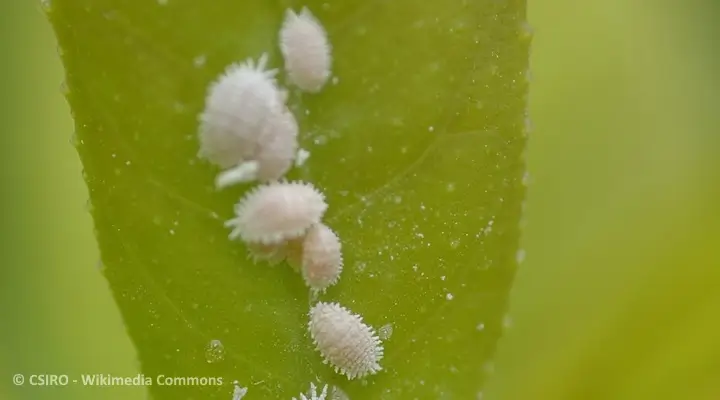
I thought it was dust until I touched it and it squished—instant horror. Mealybugs covered my Monstera overnight. Alcohol swabs saved it, but I had to repeat every few days. – r/houseplants
Whiteflies and Woolly Aphids
Tap the pot and a cloud of whiteflies flutters up—like someone shook a snow globe. Their cousins, woolly aphids, stick around, hiding under a fluffy wax coating that looks innocent until leaves start curling. Both drain sap, both spread sooty moulds, and both adore warm, stuffy corners. (Source: RHS)
One plant parent shared: “Every time I watered, these tiny white moths flew up like confetti. Turns out—whiteflies. I sprayed Neem oil, but it took two weeks before they stopped reappearing.”
Not all sap-suckers wear white. When soft green or black clusters show up on new leaves, here’s how to fix it fast: Aphids on Houseplants: Natural Ways to Get Rid of Them.
Soil Mites or Root Aphids — Hidden in the Pot
If your soil looks alive, it might be. Soil mites and root aphids throw underground parties, feasting on roots and decaying matter. They scatter when you water, leaving that weird powdery residue. Think of them as the freeloaders of damp pots—harmless at first, then quietly destructive.
Scale Insects — The Sneaky Shells That Stick Around
They don’t crawl, they cling. Scale insects glue themselves to stems and veins, blending in until your plant starts yellowing for no reason. Under those shell-like bumps, they’re busy sucking sap and leaving sticky trails behind. They’re quiet pests—the kind you notice only after the damage is done.
“I didn’t even realize they were bugs—I thought it was part of the stem. Found out the hard way after sticky honeydew appeared everywhere.” – Plant novice on Reddit
Springtails — The White Bugs Infesting Your Houseplant Soil
Ever water your plants and see white specks jump like popcorn? Meet the springtails. Tiny, harmless jumpers that thrive in damp potting mix. They won’t hurt your plants, but they’re your soil’s way of saying, “I’m too wet.” Dial back the moisture and they’ll bounce right out.
If your plant’s leaves look scratched or silvered instead of sticky, thrips might be to blame and they can be difficult to distinguish from springtails. See the early signs and real fixes in Thrips on Plants: Spot, Treat, and Prevent the Damage.
Are White Bugs Harmful to Houseplants?
Yes. Most white bugs on houseplants are sap-feeding insects—true bugs in the Hemiptera order—that drain nutrients from leaves and stems. The plant killers eventually destroy plants if they are not removed. Severe infestations stunt growth and weaken the plant’s immune system, making it vulnerable to root rot and other pests.
Still not sure what’s crawling around your pots? Use this quick visual guide to match symptoms to pests: Houseplant Pest Identification Guide.
How to Get Rid of White Bugs Naturally: Step-by-Step Guide
You don’t need harsh chemicals to beat white bugs. Most infestations clear up with a few household ingredients and consistent care. This method focuses on safe, pet-friendly treatments that remove pests, clean residue, and prevent eggs from hatching in the soil.
Step 1: Wipe with Rubbing Alcohol (Isopropyl Alcohol)
The fastest way to stop an infestation? Go straight for the bugs you can see. Rubbing alcohol is your precision tool—it melts their waxy armor on contact and wipes away that sticky residue they leave behind. Think of it as the houseplant equivalent of a spot treatment.
- Dip a cotton swab or pad in 70% isopropyl alcohol.
- Gently wipe visible bugs, leaf joints, and undersides.
- The alcohol dissolves their protective wax, killing them on contact.
- Repeat every few days until no residue or new clusters appear.
Step 2: Wash and Treat Using Neem Oil or Insecticidal Soap
Mix a mild Neem oil spray and mist every seven days, focusing on stems, leaf undersides, and soil edges. It works as a natural insecticide that disrupts pest growth and repels new ones. For full mixing ratios and safety details, see your Neem Oil for Houseplants guide.
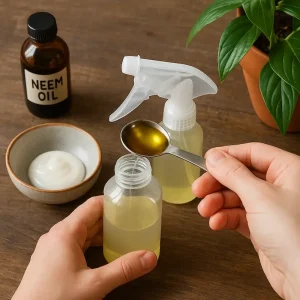
Step 3: Use Hydrogen Peroxide for Soil Mites and Root Mealybugs
When the problem runs deeper—literally—it’s time to refresh the potting mix. Hydrogen peroxide isn’t just for cuts—it’s a quiet powerhouse for flushing out root mealybugs and soil mites. It kills pests, oxygenates tired roots, and leaves the soil feeling fresh again.
- Mix 1 part 3% hydrogen peroxide with 4 parts water.
- Slowly pour through the soil until it drains.
- The fizzing action oxygenates roots and kills soil mites or root mealybugs hiding below the surface.
- Use only when needed; frequent treatments can dry roots.
Step 4: Repeat and Monitor
White bugs reproduce fast. Reapply sprays weekly for two to three weeks and check nearby indoor plants for early signs. Add sticky traps to track new activity and keep humidity moderate. Consistency—not intensity—is what keeps your plants pest-free long term.
Preventing White Bugs from Coming Back
White bugs are relentless—miss one egg cluster, and they’ll make a comeback tour across your shelves. The good news? Prevention’s simple once you know where they hide and how they spread. A few steady habits keep your indoor jungle clean, balanced, and bug-free for good.
Want to keep white bugs away from your prized houseplants for good? Here are a few tried and tested tips:
- Quarantine new plants for at least two weeks before adding them to your main collection.
- Inspect leaf joints and undersides regularly for white residue or sticky honeydew.
- Sterilize pruning tools and pots with mild alcohol before reuse.
- Water less frequently—damp soil invites springtails, root aphids, and soil mites.
- Keep airflow moving with a small fan to deter flying pests.
- Wipe leaves monthly with diluted Neem oil for gentle, natural protection.
- Empty saucers after watering to avoid standing moisture.
- Use sticky traps near high-risk plants to spot early pest activity.
- Refresh topsoil every few months to remove eggs or mold buildup.
- Avoid crowding plants, giving each one breathing space and sunlight circulation.
A plant experts on Reddit summed it up perfectly: “Once I started quarantining new plants and wiping leaves every month with Neem oil, I stopped seeing white bugs completely. It’s wild how a few small habits made more difference than any spray ever did.”
Are Natural White Bug Treatments Safe for Pets and Kids?
Mostly, yes—but “natural” doesn’t mean foolproof. Neem oil and rubbing alcohol are safer than chemical sprays, but they still need respect. Always dilute, spray outdoors or by an open window, and let plants dry before pets wander back in. Gloves on, mist light, and you’re good.
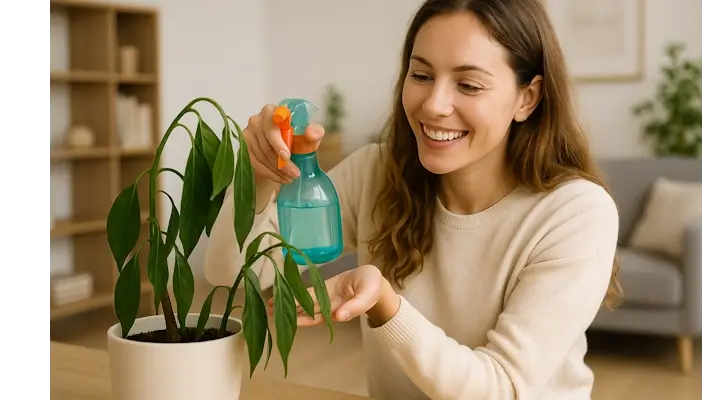
The National Pesticide Information Center confirms Neem oil is considered low-risk and is even used in toothpaste and cosmetics. Experts say that it’s “practically non-toxic to birds, mammals, bees, and plants.”
Still, concentrated forms can irritate skin, and cats seem especially sensitive. NPIC also notes it’s slightly toxic to fish and aquatic life—so skip spraying near aquariums or pet water bowls.
Plant Recovery Timeline: What to Expect After Treatment
Here’s the truth: your plant won’t bounce back overnight. The bugs die fast, but your leaves need time to heal. Give it three to four weeks—watch for new growth, fewer sticky spots, and brighter leaves. That’s your sign the battle’s over and your jungle’s safe again.
What recovery looks like:
- Week 1: Fewer crawling specks, sticky mess fading.
- Week 2: New leaves peek out while old ones stay scarred.
- Week 3–4: Plant perks up; color returns.
- After 1 Month: No pests? You’ve officially won—just keep an eye on the neighbors.
White Bugs on Houseplants: FAQs
White Bugs on Houseplants: FAQs
How long does it take to get rid of white bugs?
Most infestations clear within two to three weeks if you stay consistent with cleaning, Neem oil sprays, and soil checks. Skipping treatments lets eggs hatch and start the cycle again.
Can hydrogen peroxide kill root mealybugs?
Yes. A diluted mix of one part 3% hydrogen peroxide to four parts water helps flush out soil pests while oxygenating plant roots.
Is Neem oil safe for pets once dry?
Yes—when properly diluted and fully dry, Neem oil is considered safe around pets. Always spray in a ventilated area and keep cats and dogs away until leaves are dry.
Why do white bugs keep coming back?
Reinfestation happens when eggs or hidden colonies survive early treatments. Consistent cleaning, quarantining new plants, and monthly Neem oil leaf wipes prevent repeat outbreaks.
